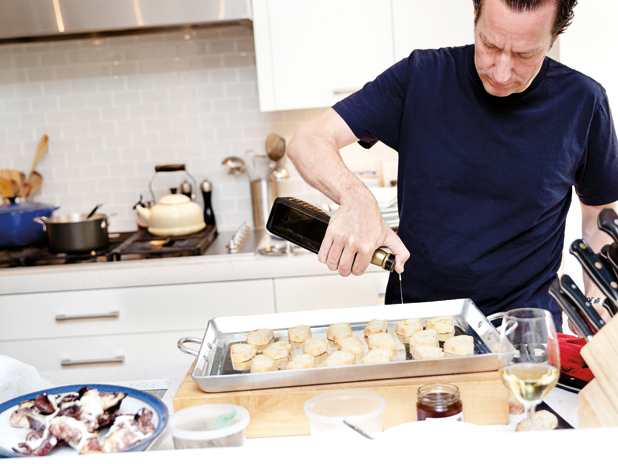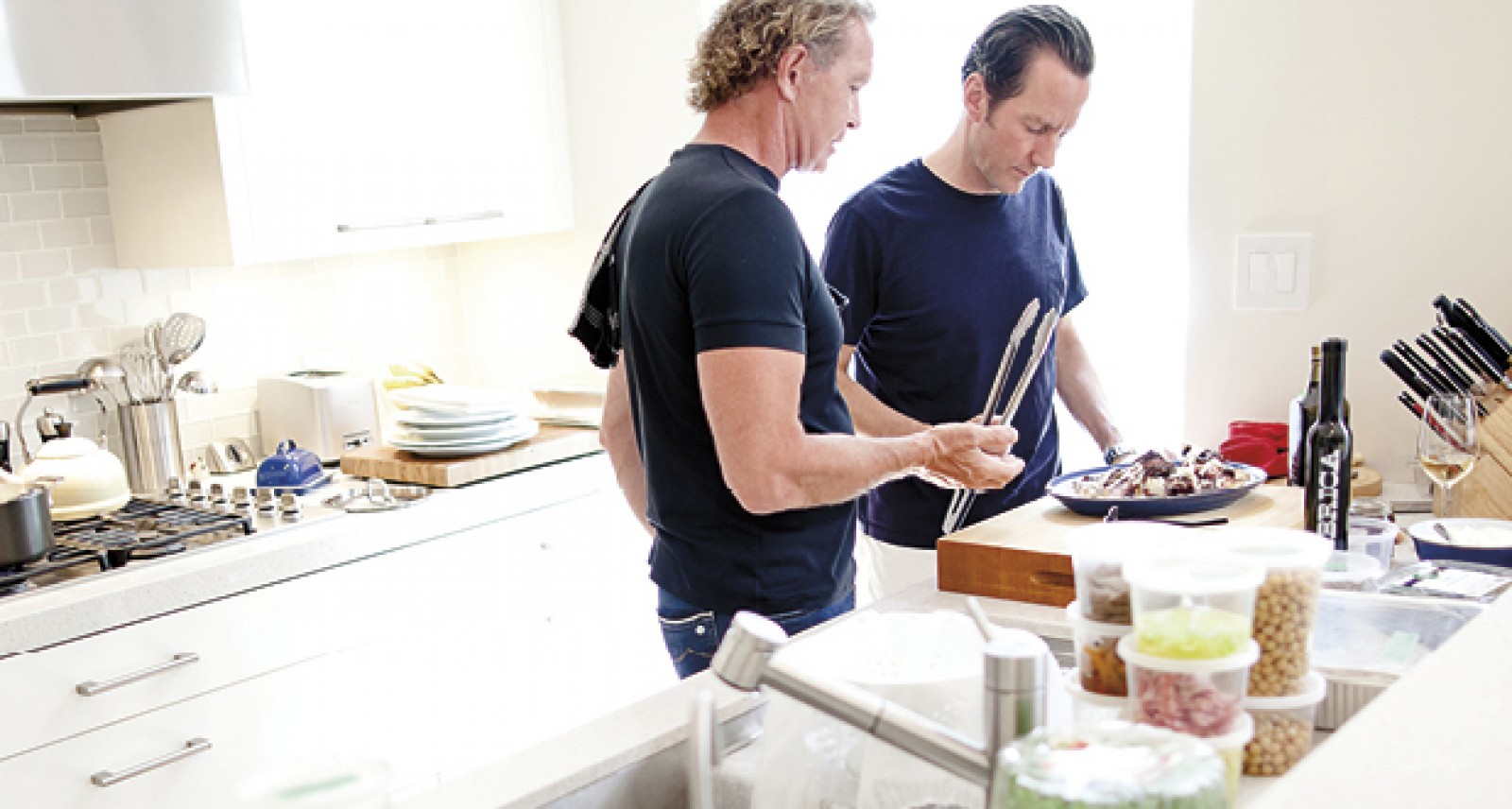The first sensible thing to do when setting out to cook an elaborate, multi-course meal for a dozen-odd guests is to line up a helpful sous-chef. Someone who knows what’s what in the kitchen: not just how to cook, but in what order to go about things. In my experience Mark McEwan is pretty good if you can get him.
“How about I get started on making the ricotta, and you get organized for the risotto?” I suggested to him one recent afternoon, with a view to sensibly dividing up the chores.
He voiced no objection; but all the same he ignored completely, and got to work on the ricotta himself. On which note I will say only that while it is usually best to find kitchen help that can be trusted to follow simple instructions, sometimes peace in the kitchen requires that one simply go with the flow. In this case, I quietly got to work on the support items for his ricotta dish: crostini, figs and honey.
This was to be the first course of our six-course spread, of which each element was pulled more or less intact from our most recent cookbook collaboration, published in late 2011 by Penguin Canada in hardcover as Mark McEwan’s Fabbrica (and more recently in softcover as Rustic Italian).
We had selected recipes from the book by applying the same criteria that everyone should keep in mind while drawing up a menu for a grand dinner party that they intend to cook themselves. So here follow our rules to cook by.
First, choose your dishes to reflect the best that season and place have to offer. And try and remember just because you can find apples in the supermarket in June, and asparagus there in December, it does not mean that they have any relationship at all with your time and place other than that it was stamped on their shipping address.
I am not advocating being obsessive and doctrinaire about what’s local. Just that you try and keep in mind that—like you—most produce finds the experience of long-distance travel to be deeply wearying. So given the option always choose what’s in season that has not been frozen unnecessarily or travelled undue distance. And if you don’t know what fills the description, look it up.
That small amount of research will pay dividends in the flavours of what you put on the table—all before you’ve even lifted a chef’s knife or wielded a wooden spoon. On which front, with all that hard work looming, let’s next address how to plan your menu sensibly.
Photography by Josh Fee & Robin Gartner
SHARE THIS POST

Never commit to cooking more than you can ably manage. Always resist the temptation to impress guests with elaborately complicated dishes. Do that by getting what you do cook exactly right, and serving it on time, instead of leaving people waiting and wondering, while you absent yourself yet again for another panic-stricken session in the kitchen.
No wise professional chef ever plans a banquet wherein one labour-intensive kitchen-challenging course immediately follows another. And you should do as they do, and balance your meal and workload by mixing up labour-intensive dishes with others can be made ahead and easily finished à la minute. That way you’ll have leeway in your action plan, so that even if something goes wrong things will turn out reasonably well.
Fabbrica is a good source book because it is all about big flavours and honest cooking, and there isn’t a recipe in the lot that requires anyone to take a week off work to produce, or to raid their children’s education funds to buy a new immersion circulators or ice-chipper or any other single purpose kitchen equipment that they will never use again. Better yet, all the recipes have flexibility to accommodate vagaries of season or even a short cut or two. And all lend themselves to the convivial eventuality of being served family-style.
McEwan’s draft menu included several of my favourites—which I still make regularly at home—like the aforementioned ricotta, served with the fall season’s peerless figs, and a composed chickpea salad topped with grilled octopus. I also regularly toss up the suggested main course of pinot grigio-braised rabbit with olives and wild mushrooms. For its principle accompaniment we settled on a luxurious, creamy squash-and-bacon risotto. There would also be roast beets with pistachios and finally, a delicate and jiggly panna cotta, dressed up with the season’s finest peaches. Simple, seasonal and— all very doable in an afternoon.
“These recipes all eat really, really well,” Mark said as he reviewed the menu. “It’s tasty food, and just right for adventurous cook.”
When said cook was done, I figured, there would be applause, and hopefully a large glass of grappa and a fine cigar. But first there was work to do. And when it comes to your turn, focus first on those things that can—and need—to be made ahead. As in a day or two ahead.
“You don’t want to leave all this to the last minute,” McEwan cautioned. “If you start the morning of you’re going to be… highly challenged.”
Make a list of your chores. Prioritize. And at the top of your list put the panna cotta, which must rest and set in the fridge for at least day before your dinner. Do not try and cut corners and make a large dish instead of the individual portions outlined in the accompanying recipes—because the key to a good panna cotta is the soft, creamy quality that comes from a minimalist gelatine count. And what you prepare that way is too delicate to be portioned after it has set.
As for the fresh ricotta, be advised that any of your guests who have previously only ever eaten it from a supermarket-purchased tub will find this one to be a revelation. Especially when it is served still vaguely warm from the pot. It is light, sweet, lemony and fine grained—and best yet, it is extraordinarily easy to make.
“People are so impressed when you make cheese—like it’s magic,” McEwan observed as he combined milk, cream and salt in a pot. ”But this is so simple…”
Indeed what’s required is simple in every respect. Unlike in the preparation of other cheeses no rennet or lipose powder or anything remotely obscure are required: only lemon juice is needed to perform the curdling trick. First, bring the dairy to a gentle simmer (never a rolling boil). Then let it sit a few minutes, and you are ready to drain the whey from the solids.
”Where is the cheesecloth? Do you have a spider—a real spider?” McEwan asked.
I found the cheesecloth for him. And I did have a spider—a sort of over-sized strainer slotted spoon-hybrid—which he used to gently transfer milk solids from the pot to cheesecloth-lined colander. And there it drained while I cut up some baguette, sprinkled the slices with olive oil, salt and pepper, and toasted them. Slice up the figs and dish one was pretty much done.
At which point you should rightly be thinking: “I can stir milk and cream. I can strain stuff. I can make toast—and probably even get it all right the first time. How about a challenge?”
So without further ado let’s move along to our next course: octopus. The steak of the sea has been enjoying its moment in the spotlight of late, spreading its legs well beyond its local, introductory realm of the sushi bar. If you want octopus these days you’ll find it with a steak knife plunged through its head at the west-end Toronto hotspot Bar Isabel and served with rose jelly, snap peas and kohlrabi at Vancouver’s trendy Farmer’s Apprentice and countless other places in between.
With all the culinary attention lavished upon the octopus of late comes some predictable mystique about how best to make it tender. Some culinary cultures recommend bashing them against the rocks. Others promote simmering them with corks, or repeated blanching. But here is the shocking fact of it: if you buy an octopus at a fishmonger hereabouts you don’t actually have to do anything to it at all. Because they all come pre-tenderized courtesy of your local fish processing plant, where they are bashed around in chilled cement mixers. All you need to do is simmer it gently in a mix of garlic, parsley and its own juices until cooked. Or if you prefer, buy a handful of pre-cooked legs at a top-quality grocer (like, well, McEwan Fine Foods). Once you get that far, all you need to do is prepare the other elements of your salad, and set it all aside until you are ready to brush the legs with butter and grill them briefly, before tossing everything together at the last minute for service.
“More wine?” I asked, uncorking a tip top ’06 Chassagne-Montrachet while I waited for my Big Green Egg to get up to temperature.
We were making real progress now. I had tuned the XM riadio to Seriously Sinatra, in honour of Mark’s dad, who was a crooner (and as Mark tells it, sounded just like Sinatra).The rabbit was simmering gently. On which front take note: rabbit has a reputation for both blandness and dryness, but neither is deserved. The flavour is mild—but when properly treated, the meat is supple and succulent. And more importantly it yields a rich sauce of most pleasing viscosity. Here follows the correct approach to getting there.
Remember first that rabbit must be cooked gently—and never quickly. The second key to success is that like most animals not all parts of it require the same amount of cooking. And when that trait is combined with its leanness there is not room for error. So what you need to do is to stagger the timing of its various parts vis-à-vis their arrival in the pot in order for them all to be ready and at their prime at precisely the same time—and monitor it all carefully as they get there (see recipe for details). Do so and you will be rewarded. Or your guests will.
“I’ll sauté the bacon while you get the risotto started, okay?”
It was okay with him. So with the rabbit simmering we got started on its principle accompaniment, as Mark told me about his newest business plans—a new branch of McEwan Fine Foods—downtown this time—in the TD Centre, basement level, down the length of the corridor alongside Bymark. The emphasis will be on prepared foods—especially on what the industry calls restaurant replacement meals.
“Think about all those people passing by as they head home after work,” he said, with obvious pleasure at the prospect.”All they have to do is email me to say what they want ready and packed to take home at 5:15….”
Risotto is deceptively tricky. At least it is the first time out, or until you get a feel for it. Because risotto rice differs greatly—not just type to type, but brand to brand and package to package. And developing a feel for how starchy each one is, and how much you need to stir it (or not stir it) in order to arrive at the desired result is key to turning out a good batch.
It is a recipe best learned not from a book, but at someone’s shoulder. Preferably that of someone’s experienced Italian nonna. In McEwan’s case, like so many other Toronto chefs back in the ’80s, he learned the risotto ropes from restaurateur Franco Prevedello. In mine, I learned from McEwan when he came to visit my family cottage on Lake Memphremagog in Quebec. I hope you have similar luck.
But whether you do or don’t remember one important thing: all that talk about it being impossible to reheat risotto is vastly exaggerated. This is simply not true of the stuff prior to the Parmesan being added to the mix. So if you stop a few minutes shy of that stage, and cool it quickly (in the fridge, spread thin on a baking sheet), you can later pick up where you left off five minutes from the end without any deleterious effect whatsoever. Restaurants do this all the time and you can, too.
Secondly, in the finishing, aim for a texture that is luxuriously wet—for the starch in the mixture dries fast on the plate, and creamy becomes sticky and dry before you know it. McEwan was blending out batch like a master: as made its final approach to a state of al dente doneness, in went the pumpkin purée, and the diced pumpkin, and then the bacon. Then the heat went off and the parmesan and butter were stirred in—and it looked perfect.
“Taste the seasonings for me?” he asked.
It was as perfect as it looked, the smoky bacon and sweet pumpkin perfect counterpoints.
“That with roast turkey… delicious!” he said.
But turkey was for another day. Today we still had to sauté the beets, dress them with a balsamic glaze, and sprinkle them with pistachios. If the peach-topped panna cotta was overkill nobody said so.




